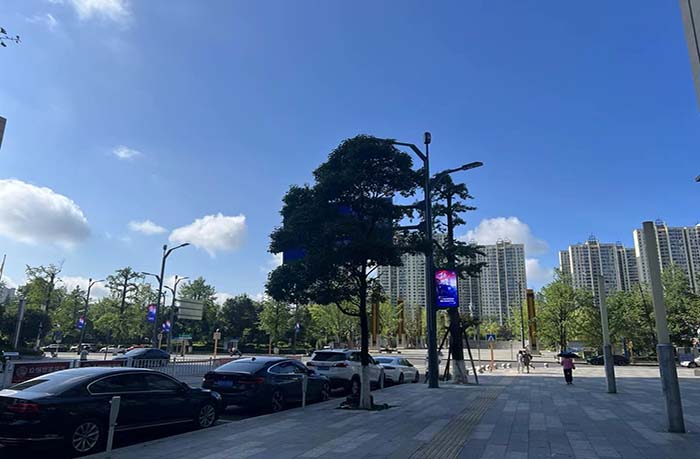Smart lamp pole screens are emerging as essential elements in the infrastructure of modern cities. These multifunctional devices combine lighting, digital advertising, and public information into one compact system. As cities become smarter, optimizing the weight of these screens has become a critical design consideration. Reducing weight not only ensures safety and ease of installation but also improves cost efficiency and visual integration. This article explores why weight matters and how manufacturers and city planners can achieve an optimal balance.

Weight is a core factor that influences the performance, safety, and design feasibility of smart lamp pole screens. Here's why:
Heavy displays place additional stress on the lamp pole and its foundation. If not properly accounted for, this extra load can lead to structural weaknesses, especially in areas prone to strong winds or seismic activity. Ensuring that the screen’s weight is within safe limits is crucial for long-term reliability and public safety. Engineers must conduct thorough assessments to confirm the load-bearing capacity of poles and their foundations before installation.
The choice of materials significantly affects the weight and performance of the screen. Lightweight, high-strength materials such as aluminum alloy and fiberglass are commonly used to reduce load while maintaining durability. These materials also offer corrosion resistance and thermal stability, making them ideal for long-term outdoor applications. By prioritizing materials with a high strength-to-weight ratio, manufacturers can enhance both performance and serviceability.
A lighter smart pole screen means a smoother and faster installation process. It typically requires fewer personnel, lighter equipment, and shorter installation time. Likewise, ongoing maintenance becomes easier, reducing the need for cranes or heavy machinery. This can result in significant cost savings across the lifespan of the product and lower the risks during on-site servicing.
Oversized or overly heavy screens may look out of place, detracting from the aesthetics of streetscapes or public spaces. Lightweight displays are easier to design in slimmer, more modern forms that blend seamlessly with smart poles and the surrounding architecture. This contributes to a more cohesive and visually appealing urban environment.

Achieving an optimal weight requires smart design practices and advanced engineering. Here are some proven approaches:
Engineers can apply lightweight design methods, such as using hollow or honeycomb structures, to reduce unnecessary mass without weakening the frame. Thin-wall engineering also allows for slimmer casings while preserving rigidity. These structural optimizations help minimize material usage, resulting in a lighter, more efficient product.
Innovations in material science have introduced options like carbon fiber-reinforced composites and advanced polymer blends. These materials offer exceptional strength while dramatically cutting down on weight. Their resilience in outdoor conditions and long service life make them ideal for smart city applications. Incorporating such materials can also improve thermal management and weather resistance.
Before going to production, designers can use simulation tools to model load distribution and environmental stress responses. These virtual tests help identify weak points and over-engineered areas. Combined with real-world testing, this process ensures that the final product strikes the right balance between weight, safety, and performance.

Optimizing the weight of smart lamp pole screens delivers numerous operational and economic benefits:
Lower Project Costs: Lightweight designs cut down shipping, installation, and maintenance expenses.
Improved Public Safety: Reduced load on poles minimizes the risk of failures or accidents.
Better Visual Integration: Slimmer screens contribute to clean, modern streetscapes that align with urban design standards.
Long-Term Durability: Advanced materials and thoughtful engineering reduce wear and tear, extending product lifespan.

Weight optimization is not just a design consideration—it’s a cornerstone of successful smart lamp pole screen deployment. By selecting the right materials, leveraging innovative structural designs, and validating through simulation, manufacturers can deliver products that are safer, more efficient, and better suited to the evolving needs of smart cities. As material technology advances, we can expect even lighter and more integrated solutions to support smarter, greener urban infrastructure.

